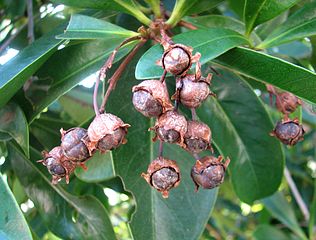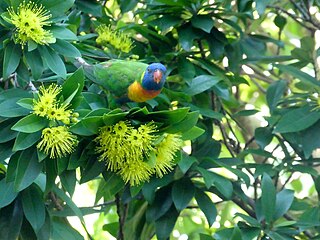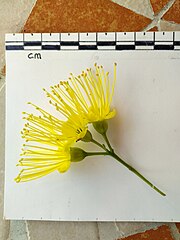Xanthostemon chrysanthus
| Golden penda | |
|---|---|

| |
| Golden penda tree in Brisbane | |
| Scientific classification | |
| Kingdom: | Plantae |
| Clade: | Tracheophytes |
| Clade: | Angiosperms |
| Clade: | Eudicots |
| Clade: | Rosids |
| Order: | Myrtales |
| Family: | Myrtaceae |
| Genus: | Xanthostemon |
| Species: | X. chrysanthus
|
| Binomial name | |
| Xanthostemon chrysanthus | |
| Synonyms[3] | |
| |
Xanthostemon chrysanthus, commonly known as golden penda, is a species of tree in the myrtle family Myrtaceae which is endemic to (found only in) north eastern Queensland, Australia.[4] It is a popular garden plant with showy yellow blooms, and is the floral emblem of the city of Cairns.[5][6]
Description
Xanthostemon chrysanthus is as a tree growing up to 25 m (82 ft) high, and the rough-barked trunk may be buttressed.[7][8] In its preferred habitat alongside rainforest creeks, the trunk will often be gnarled and twisted.[4] It has a dense crown, with the dark glossy green leaves clustered towards the ends of the branches.[8][9] The simple (i.e. without lobes or divisions) leaves are arranged alternately or in whorls.[7][9] They are generally elliptic and measure up to 22 cm (8.7 in) long by 9.5 cm (3.7 in) wide.[7][9]
The inflorescence is a terminal or axillary panicle which forms dense, showy heads of golden flowers.[7] The calyx is green with 5 lobes and is about 1.5 cm (0.59 in) wide; petals are yellow or yellow-green and up to 9 mm (0.35 in) long.[4][7][9] The most conspicuous aspect of the flower is the numerous stamens, which are bright yellow and up to 3 cm (1.2 in) long,[4][7][10] making the overall diameter of the flower about 5 cm (2.0 in).[8] Flowering can occur at any time of year, particularly after heavy rain events.[6][11]
The fruit is a woody capsule about 1.5 cm (0.59 in) diameter, and contains between 2 and 4 small black seeds about 4 mm (0.16 in) long. The capsule splits open at maturity and releases the seeds.[4][7]
Taxonomy
This species was first described in 1864 by the Victorian Government botanist Ferdinand von Mueller as Metrosideros chrysantha, based on material collected by John Dallachy on 12 April 1864 from Rockingham Bay in northern Queensland.[2][4] In 1891 the German botanist Otto Kuntze published a revision of the taxon, and gave it the new combination Nania chrysantha.[2][3] Finally, it was reclassified in the genus Xanthostemon by George Bentham in the third volume of his Flora Australiensis in 1867.[2]
Etymology
The species name is derived from the Ancient Greek words chrysos "golden", and "anthos" "flower".[11]
Distribution and habitat
The native range of the golden penda is from the Seaview Range near Ingham northwards to the area around the Pascoe River in Cape York Peninsula.[4][7] It is most commonly found alongside creeks and rivers in rainforest, and at altitudes from sea level to 1,000 m (3,300 ft).[4][7]
Ecology
The profuse flowering attracts many nectar eating birds, including rainbow lorikeets (Trichoglossus moluccanus) and friarbirds (genus Philemon).
Cultivation
Xanthostemon chrysanthus is cultivated as an ornamental plant for use in gardens and park landscaping but will only reach about 12 m (39 ft) in height in such situations.[8][9][10] Its horticultural appeal stems from its profuse and attractive flowering.[4] It can be propagated by seed or cuttings but will flower sooner when grown from cuttings.[8] It grows well in subtropical gardens with fair drainage and sunny aspect,[11] but in cooler climates such as Sydney, the tree will not flower as profusely as it does in its native range.[10]
Expo gold
The golden penda was selected as the theme plant for Expo 88. Cuttings of the tree were taken from a superior form from a garden in Brisbane and planted in flower in Brisbane to create a 'Sea of Gold'. In late autumn, the tree can still be seen in flower in gardens and lining streets across Brisbane.[8]
Gallery
-
Flowers
-
Fruit, almost ready to split open
-
On the Cairns foreshore, with a Rainbow lorikeet feeding on the flowers
-
Individual flowers
-
Dehisced fruit
References
- ^ "Species profile—Xanthostemon chrysanthus". Queensland Department of Environment and Science. Queensland Government. 2022. Retrieved 17 May 2023.
- ^ a b c d "Xanthostemon chrysanthus". Australian Plant Name Index (APNI). Centre for Australian National Biodiversity Research, Australian Government. Retrieved 17 May 2023.
- ^ a b c "Xanthostemon chrysanthus (F.Muell.) Benth". Plants of the World Online. Royal Botanic Gardens, Kew. Retrieved 17 May 2023.
- ^ a b c d e f g h i F.A. Zich; B.Hyland; T. Whiffen; R.A. Kerrigan. "Xanthostemon chrysanthus". Australian Tropical Rainforest Plants (RFK8). Centre for Plant Biodiversity Research, Australian Government. Retrieved 27 May 2021.
- ^ "City symbols". Cairns Regional Council. 27 May 2016. Retrieved 30 November 2019.
- ^ a b "Golden Penda". The Society for Growing Australian Plants, Cairns Branch. Retrieved 30 November 2019.
- ^ a b c d e f g h i Cooper, Wendy; Cooper, William T. (June 2004). Fruits of the Australian Tropical Rainforest. Clifton Hill, Victoria, Australia: Nokomis Editions. p. 372. ISBN 9780958174213.
- ^ a b c d e f Norm McCarthy (June 2003). "Growing Golden Penda". Australian Plants Online. Australian Native Plants Society (Australia). ISSN 1326-7469. Retrieved 19 May 2023.
- ^ a b c d e Clarke, Dan (2021). "Xanthostemon chrysanthus". Australian Plants Society New South Wales. Retrieved 19 May 2023.
- ^ a b c Walters, Brian (2007). "Xanthostemon chrysanthus". Australian Native Plants Society (Australia). Archived from the original on 16 June 2013. Retrieved 19 May 2023.
- ^ a b c Elliot, Rodger W.; Jones, David L.; Blake, Trevor (2010). Encyclopaedia of Australian Plants Suitable for Cultivation: Volume 9 – Sp-Z. Port Melbourne: Lothian Press. p. 498. ISBN 978-0-7344-0974-4.
External links
 Data related to Xanthostemon chrysanthus at Wikispecies
Data related to Xanthostemon chrysanthus at Wikispecies Media related to Xanthostemon chrysanthus at Wikimedia Commons
Media related to Xanthostemon chrysanthus at Wikimedia Commons- View a map of recorded sightings of this species at the Australasian Virtual Herbarium
- View observations of this species on iNaturalist
- See images of this species on Flickriver
- Articles with short description
- Short description matches Wikidata
- Use Australian English from May 2023
- All Wikipedia articles written in Australian English
- Use dmy dates from May 2023
- Nature Conservation Act least concern biota
- Articles with 'species' microformats
- Commons category link from Wikidata
- Taxonbars with automatically added basionyms
- Xanthostemon
- Myrtales of Australia
- Flora of Queensland
- Endemic flora of Australia
- Garden plants of Australia
- Ornamental trees
- Taxa named by Ferdinand von Mueller




